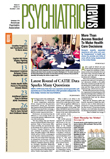When I initially expressed interest in a career in psychiatry, I was commonly asked, “Are you sure you want to work with crazy people for the rest of your life?” I devised a rote reply, fortified by unshakable confidence and optimism for the purpose of alleviating their genuine anxiety about my career choice. However, over time I began to wonder whether I had committed myself to a career-long sense of regret.
Mrs. P was dying of lung cancer and was the first terminally ill patient I worked with as a third-year medical student. At first I was frightened to get too close to her during my early-morning rounds. Intellectually I understood that her disease was not contagious, but I somehow felt that I would get contaminated with the dark spirit of death surrounding her. Yet I was conflicted because she seemed so impassioned and so content that I was simultaneously drawn to her.
In medicine, the preservation of life and prevention of death are among the most prominent goals of our work. When I asked “Are you afraid to die?” she slowly and softly found my hand—instantly making me aware of my rapid pulse as my neck veins beat against my tight collar.“ Not at all,” she replied. She went on to tell me what a wonderful life she had lived and that she accepted that it was her time to move on. I looked forward to holding her hand every morning until her final day. I learned along the way that there is nothing wrong with holding the hand of a dying patient and that this was, in fact, one of the best treatments I could offer some patients.
My relationship with Mrs. P provided a foundation for examining the issues of providing support and appropriate clinical distance during my psychiatry residency. Clinical distance defines the professional relationship between a doctor and patient as different from a personal one. What are the options regarding clinical distance? Examples of being too close, just close enough, and too distant can all be found in the history of psychiatry. Finding the right clinical distance is akin to performing a delicate dance between the task, goal, and bond of the patient and therapist.
Why is preserving the alliance balanced with creating appropriate clinical distance so important? From my readings of Sullivan, Havens, and others, the relationship between patient and therapist (the “alliance”) is the most important tool psychiatrists have to help their patients achieve positive outcomes. The alliance between the patient and the doctor congeal to serve as a beacon—one that contains the power to pierce through the fog of mental disease. This light has the ability to illuminate the path leading toward mental health recovery. Our patients come to us cloudy, their minds muddied by their symptoms. Understanding the personhood of the patient aids in the allimportant alliance formation.
I was able to find the person in Mrs. P because I came to understand her wellness, not just the diagnosis of her illness. In many medical specialties there are key concepts of health promotion and disease prevention, but in psychiatry there is an emphasis on mental illness. I propose that we conceptualize our psychiatric patients in a frame of mental health, not mental illness. It is the unfortunate truth that by conceptualizing our patients in terms of mental illness, we foster a problem-based schism of the individual. The current gold standard for diagnosing mental illness in our profession, DSM-IV, provides little information about what should be considered signs and symptoms of mental health. Health and well-ness are separate from one another in that health is what the clinician perceives, and wellness is what the patient perceives.
Subscribing to this framework of mental health and wellness liberates us to understand mental illness as an aspect of an overarching context of mental health. Perhaps this will aid in the eradication of the stigma of mental illness, making it much easier for physicians to find the person amid the fog of mental disease. ▪

